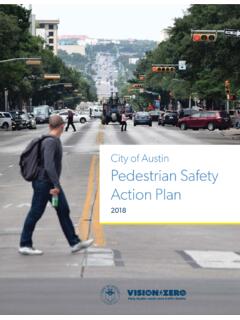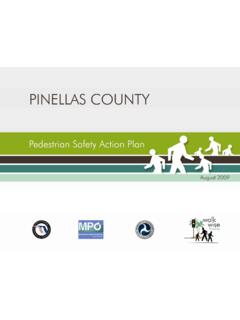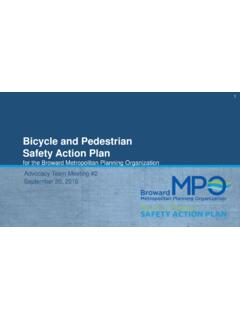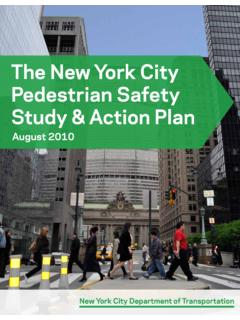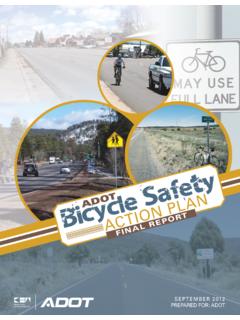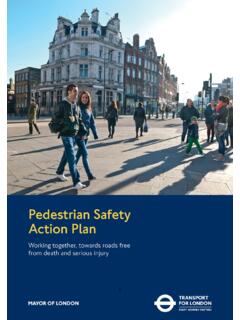Transcription of How to Develop a Pedestrian Safety Action Plan - kls-eng.com
1 How to Develop a Pedestrian Safety Action plan FHWA-SA-05-12 February 2006 How to Develop a Pedestrian Safety Action plan FINAL REPORT Prepared for: Office of Safety Federal Highway Administration Project Manager: Tamara Redmon Prime Contractor: BMI-SG, a VHB Company Report Authors: HSRC Authors Charles V. Zegeer Laura Sandt Consultant Authors Michael Ronkin Mike Cynecki Peter Lagerwey HSRC Student Contributors Helen Chaney Bastian Schroeder Emily Snyder Report Design and Layout: Laura Sandt Pedestrian and Bicycle Information Center Highway Safety Research Center University of North Carolina Campus Box 3430 730 Martin Luther King, Jr. Blvd Chapel Hill, 27599-3430 February 2006 Acknowledgements The project team would like to recognize and express appreciation to the numerous individuals who contrib uted information, case studies, and feedback for the Guide.
2 They include: Dwight Kingsbury, Assistant State Pedestrian /Bicycle Coordinator, State Safety Offi ce, Florida Depart ment of Transportation. Craig Raborn, Program Manager for Technical Information, Pedestrian and Bicycle Information Center, Highway Safety Research Center, University of North Carolina at Chapel Hill. Charles Crim, Project Development Engineer, Local Roads and Streets, Illinois Department of Transpor tation. Nancy Okasaki, Transportation Planner, Metropolitan Transportation Commission, San Francisco Bay Area. Gabriel Rousseau, Transportation Specialist, Office of Safety Programs, Federal Highway Administration, Department of Transportation.
3 Elise Bremer-Nei, Supervising Planner, New Jersey Department of Transportation, Office of Bicycle and Pedestrian Programs. Richard Haggstrom, Senior Transportation Engineer, California Department of Transportation. Dave Bachman, Bicycle/ Pedestrian Program Manager, Pennsylvania Department of Transportation. Kohinoor Kar, Transportation Engineer, Traffic HES ( Safety ) Section, Arizona Department of Transpor tation. Pat Pieratte, Bicycle/ Pedestrian Safety Specialist, Florida Department of Transportation. Ken Kochevar, Safety and ITS Engineer, Federal Highway Administration, California Division. Gerard Soffi an, Office of the Director, Signs and Markings, New York City Department of Transporta tion.
4 Jim Ercolano, Pedestrian Specialist, Pedestrian /Bicycle Program, New York State Department of Trans portation Headquarters. Cara Seiderman, Project Planner, Environmental and Transportation Planning Division, Community De velopment Department, City of Cambridge, Massachusetts. Jennifer Toole, President, Toole Design Group, LLC, Maryland. Bill Cowern, Transportation Operations Engineer, City of Boulder. Ron Van Houten, Professor, Psychology Department, University of Western Michigan. Megan Hoyt, Pedestrian Safety Specialist, Pedestrian Program, Seattle Department of Transportation. Erik Landfried, Graduate Researcher, Pedestrian and Bicycle Information Center, Highway Safety Re search Center, University of North Carolina at Chapel Hill.
5 Photo Credits The images in this document were provided by a variety of individuals and agencies, including: Dan Burden Cara Seiderman Mike Cynecki Peter Lagerwey Michael Ronkin Ron Van Houten Jim Ercolano and the NYDOT The Pedestrian and Bicycle Information Center Image Library ( ) Table of Contents Chapter 1: Planning and Designing for Pedestrian Safety The Big Picture ..7 Chapter 2: Involving Stakeholders ..19 Chapter 3: Collecting Data to Identify Pedestrian Safety Problems ..26 Chapter 4: Analyzing Information and Prioritizing Concerns ..38 Chapter 5: Selecting Safety Chapter 6: Providing Funding ..81 Chapter 7: Creating the Pedestrian Safety Action plan .
6 89 References ..97 Appendix A: How to Create and Run an Effective Pedestrian Advisory Board ..105 Appendix B: How to Conduct Pedestrian Counts and Behavior Studies ..108 Appendix C: How to Conduct Pedestrian and Motorist Behavior Assessments ..111 Appendix D: List of Funding Sources ..113 Appendix E: Evaluation of a Pedestrian Safety plan 118 Appendix F: Reference Guide and plan Summaries 121 Appendix G: Pedestrian -Related Land Use Planning Resources 132 Appendix H: Checklist for Engineering and Planning Solutions 134 Appendix I: Checklist for Pedestrian Safety Action plan Elements 147 1 Introduction Introduction The purpose of this guide on How to Develop a Pedestrian Safety Action plan is to present an overview and framework for state and local agencies to Develop and implement a Pedestrian Safety Action plan tailored to their specific problems and needs.
7 A Pedestrian Safety Action plan is a plan developed by community stakehold ers that is intended to improve Pedestrian Safety in the community. An objective of the guide is to help state and local officials know where to begin to address Pedestrian Safety issues. It is also intended to assist agencies in further enhancing their existing Pedestrian Safety programs and activities, including identifying Safety problems and se lecting optimal solutions. This guide is primarily a reference for improving Pedestrian Safety through street redesign and the use of engineering countermeasures as well as other Safety -related treatments and programs that involve the whole community. This guide can be used by engineers, planners, traffic Safety and enforcement professionals, public health and injury prevention professionals, and decision-makers who have the responsibility of improving Pedestrian Safety at the state or local level.
8 Pedestrian Safety Problem Background Pedestrian crashes and the resulting deaths and injuries are a serious problem on our roadways. In 2004, 4,641 pedestrians were killed in traffic crashes, representing 12 percent of all roadway-related fatalities (National Highway Traffic Safety Administra tion, 2004). In urban areas, Pedestrian deaths typically represent 25 to 40 percent of traffic fatalities. Approximately 70,000 pedestrians were injured on roadways in 2004, and many of these were severe injuries. While reducing Pedestrian crashes has recently gained increasing priority among some state and local agencies as well as the Department of Transportation (DOT), more efforts and programs are needed to Develop and implement effective strategies to reduce Pedestrian -related injuries and deaths.
9 The Safety literature reveals a variety of risk factors that infl uence Pedestrian crashes and severity. For example, Pedestrian crash risk increases on wide roads (four lanes or more) with high motor vehicle speeds and/or volumes. Intersections are more dif In a societythat values choice and freedom, people shouldbe able to walk safely, whether for fun and rec reation, errands, getting to work or school, shop ping, or other reasons. For more crash sta tistics, see NHTSA s Traffic Safety Facts: 2004 Data, available at http://www-nrd. pdf/nrd-30/ncsa/ TSF2004 2 How to Develop a Pedestrian Safety Action plan ficult to cross when pedestrians encounter wide crossing distances, wide turning radii, multiple turn lanes, or traffic control that is confusing or complex.
10 Other high-risk factors include drug/alcohol use by motorists and pedestrians, lack of nighttime road way lighting, and the lack of walkways along roads. Older pedestrians are much more susceptible to serious or fatal injuries because of their frailty, while young children (particularly males aged 5 to 9) are more likely to be struck by a motor vehicle after darting into the street (Campbell, 2004). Many Pedestrian crashes are the result of unsafe motor vehicle driver and Pedestrian behaviors. Certain roadway designs features can contribute to unsafe behaviors by pedestrians and motorists. For example, excessively-wide streets encourage higher motorist speeds. High-volume multilane roads with a lack of safe crossings at regular intervals can contribute to pedestrians crossing streets at unsafe locations, particularly those who cannot or will not walk great distances to signalized locations.
